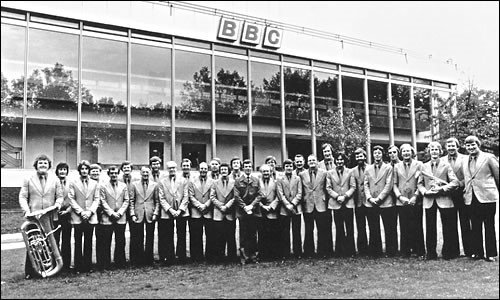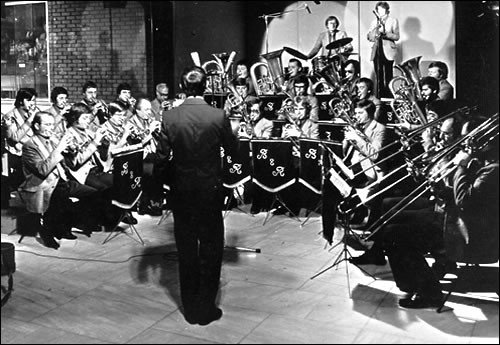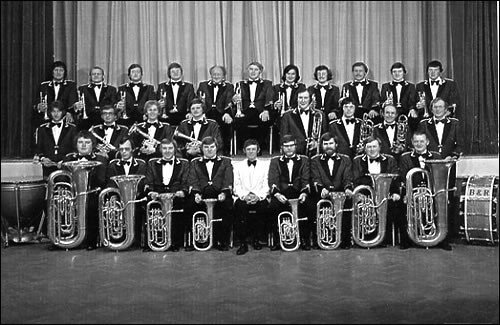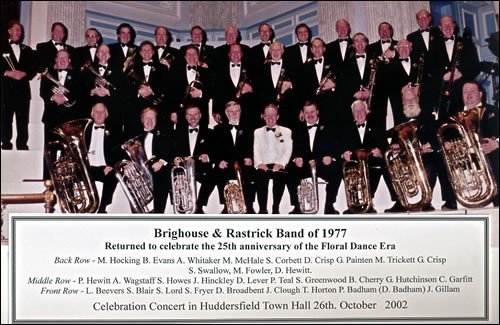brighouse & Rastrick: The Floral Dance
During the mid 1970’s, the Brighouse and Rastrick Band were, as usual, fully engaged on performing their popular brand of concerts to audiences across the UK and occasionally beyond. As today, with no financial support to rely upon from commercial sponsorship, the band had to marshall its own resources to earn its day-to-day keep. One growing way of assisting finances was to sell recordings of the band’s music (then on vinyl 12inch discs) to members of their concert audiences. The band committee at the time were discussing, as nearly always, ways of increasing their commercial activity. One idea that came out of the frequent casual after concert chats in the bar was to try to make a ‘single’ record that might have more popular appeal and so increase sales. It was agreed explore to the idea and thoughts turned to trying to identify suitable music. The band’s Musical Director, Derek Broadbent, was actively involved in these discussions and an early contender for the single idea was an arrangement of Duke Ellington’s ‘Mood Indigo’. This had been played at concerts and had proved very popular with audiences. However, other ideas were still being considered.
Meanwhile, Derek Broadbent, who worked at the University of Bradford during this period, had an inspired moment. As he walked across his office one day, part of the well-known tune of The Floral Dance came into his mind. This was a popular song written in 1911 by Katie Moss. Inspired by her visit to Cornwall where she took part in the age-old traditional Fury or Flora Dance in the village of Helston, she had becoming fascinated by the event and in response, wrote the song. The annual Flora event is a traditional festival to welcome the coming of spring and sees couples, dressed in their finery, dancing around the village and actually through many houses, to the accompaniment of the town band playing their traditional tune. Katie Moss’s song was based upon this tune and over the years gained wide popularity across the country where it had been sung by many fine singers.
So with some enthusiasm, Derek took this tune, and with his skill and talent, developed his special arrangement of The Floral Dance. He really liked the song and gave it a modern brass band treatment. Eventually it was trialled at a band rehearsal and acquired some approval from the band personnel, sufficient for agreement that it would be played as an encore item at some future concerts. Needless to say, it was well received and Mood Indigo was relegated to the B-side of the proposed single recording. Discussions regarding the project took place with the Transatlantic recording company with whom the band had worked previously. They were attracted by the idea and after a brief flirt with a rival Floral Dance arrangement, championed initially by the recording company, the famous Derek Broadbent Floral Dance arrangement prevailed and was recorded in Birmingham in 1976, en route to a concert engagement also in the Midlands the same evening.
When the recording became available it was sold as originally envisaged at concerts. No thought of it ever becoming a huge chart-topping hit was ever thought about. It was purely a means of increasing valuable income revenue to keep the band running. The recording sold quite well and was achieving its aim. Its popularity was growing, initially mainly through concert audiences, although many traditional brass band enthusiasts were still resisting its charm. However, the popularity really started to spread when copies found their way into the local radio stations that were rapidly expanding their number at the time across the country. The size of the potential audience now grew from the few hundred at each Brighouse and Rastrick Band concert performance to the thousands listening at every airing on the local radio stations.

Possibly, The Floral Dance was already well on its way to becoming a very popular hit at this stage, but Derek Broadbent believes the real break through came when the recording company created a more dynamic publicity department that promoted its products with greater effect. As a result the music gained more playing, even occasionally on national radio. Record sales rose and to the band’s surprise, reached number 70 in the top 200 of the popular music charts. The B&R version of The Floral Dance became seriously recognised as a ‘chart climber’ and contact was made for the first time between the BBC TV ‘Top of the Pops’ programme and the band committee. Over the next few weeks, as they climbed the chart, 62nd, 50th, 32nd, the band were on standby every week to appear on the BBC TV ‘Top of the Pops’ television show which at that time had millions of viewers and was the leading popular music programme in the country.
Also around the same time, The Floral Dance had attracted the attention of the producer of BBC Radio 2’s very popular early morning ‘Terry Wogan Show’. Several airings on national radio followed and Terry Wogan himself, already knowing the song, sang along to it in his usual jocular style. On Radio 2 it eventually attracted the coveted prime-playing slot of the morning, played on many occasions just before the 8am news bulletin. The demand by the public to play the music on all the popular music stations grew, consequently along with tremendous record sales. Even Terry Wogan eventually made his own singing version of the song.
As the hit grew, demand on the band to make additional radio, TV and ‘live’ show appearances, other than those scheduled in their normal programme of work, grew. Whilst this was wonderful, the 27 band players were, as today amateurs. As such they had normal jobs during the day that they still had to fulfil despite their growing fame. Playing in the band was essentially a hobby. Discussions within the band decided that this was a unique situation, no brass band had before had such a high public profile. They should try to take on the extra work they could manage, making extra appearances on radio, television, in nightclubs, on shows etc. but also trying to keep a sensible balance to the whole of life. Over the next few months, there were to be some very tolerant and understanding wives, family and employers supporting the players and the band in general. This was an experience of a lifetime not to be missed
The call to appear on ‘Top of the Pops’ eventually came and Stephen Firth, then a young reporter on The Brighouse Echo newspaper, later its Editor, accompanied the Band to the recording and wrote of the experience.
“It was late on Tuesday evening that the appearance was confirmed and that the band were due in London the following day to record. At 10am the next morning the main body, of the band left their Rydings Hall headquarters. After picking-up at Mirfield, Ossett, Woolley Edge and Barnsley, the 27-strong outfit was complete.

Coach driver Norman Crowther performed a minor miracle meeting the 2pm deadline and with only minutes to spare he pulled into the car park at Shepherds Bush. Within minutes, the band was called into the studio and a bewildered collection of musicians was suddenly among the glitter and bright lights of ‘Top of the Pops’.
Conductor Derek Broadbent swung the band into his rhythmic arrangement and several people paused as the unfamiliar strains of brass (rehearsing) reverberated through the studio.
In a little over three minutes (the Top of the Pops) recording was all over. Pausing only for an admiring glance at ‘Legs and Co’, the band dashed off to change and rejoin the coach, which would speed them back to Yorkshire.
Today members of the 1977 band still talk of that experience, recalling seeing ‘Legs and Co’ and a very young Bob Geldoff and his Boomtown Rats. They also recall that they think they were the only artists at the show who performed ‘live’, the other acts miming to pre-recorded music in front of the cameras.
Sales of The Floral Dance now went wild across the country. It jumped to No. 2 in the charts and stayed there for nine unequalled weeks. If another popular, lulling and haunting melody, Paul McCartney’s ‘Mull of Kintyre’, had not cast a similar competing spell over the buying public during the same period, The Floral Dance would have been No 1 in the pop music charts. However, sales did surpass the million mark and Silver and Gold Discs were duly awarded and are proudly displayed in the band headquarters to this day, along with the Gold Disc awarded for the sales of the following Floral Dance album. The Floral Dance also had tremendous success abroad and brought brass music to a much wider public audience.
Back home, over a period of approximate three months, the band and bandsmen enjoyed lives as local celebrities, balancing their family and working lives whilst still playing with the band in a vast range of differing situations, at many very new and surprising venues across the whole UK. They even had fans hanging around the bandroom awaiting the possibility of gaining autographs after band rehearsal finished. It was hard work and had a punishing and difficult schedule at times, but the band personnel enjoyed it.
Although many within the brass-banding world thought B&R had lost its way in 1977, the band proved them wrong by winning the traditional British Open Brass Band Championship in 1978, and it has since won many major championships including National and European titles. The Floral Dance was a brief beneficial diversion for the band away from its normal sphere of activity. But following the chart success, the financial state of the band had been given a significant boost that enabled it to have a more confident future. Whilst musical performance of the highest standard is still maintained and aspired to, the name of Brighouse and Rastrick Band is still mainly known to the wider British general public to this day because of its association with The Floral Dance, despite being one of the leading brass bands in the world. The world of brass bands was also seen in a new light as many obtained copies of the arrangement and brought their own ‘live’ version to their locality populations.


Undoubtedly, The Floral Dance was a unique phenomenon. Musically it was a catchy sound with a good tune that could easily be carried in the head. It appeared at the right time when the public were particularly responsive to it. A series of events occurred by a combination of plan, coincidence and accident to bring that music to the public who then took it to their heart and made it a huge hit. There was also that extra something that you can’t quite put your finger on! The result was outstanding and a fantastic success that no one could have predicted.
In 2002, a further unique event was arranged. To celebrate the 25th Anniversary, the 1977 ‘Floral Dance’ band re-formed for one shared concert with the then current 2002 B&R band. For the only time ever, (so far) two Brighouse and Rastrick Bands took to the stage in Huddersfield Town Hall for a memorable Celebration Concert on the same evening. The 1977 band performed a third of the concert, this being a challenge to some who hadn’t played since the late 1970’s. The 2002 band played another third whilst the combined talents of both bands united to complete a superb and very special evening of glorious brass music. Many happy memories and friendships were rekindled that weekend.
Despite a tentative move a few years ago to try to move on and maybe omit the piece from the band’s repertoire, this wasn’t to be. Concert audiences still expect and demand its playing at Brighouse and Rastrick Band concerts. So, today, The Floral Dance continues to be the encore item and still receives a great ovation from an audience, some remembering the original events in 1977 whilst some are hearing it for the very first time.
Long live ‘The Floral Dance’!
